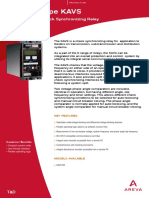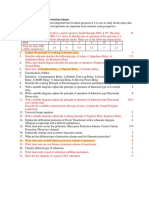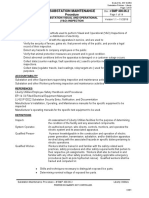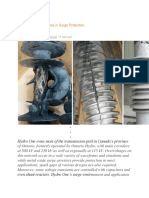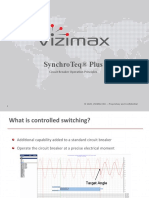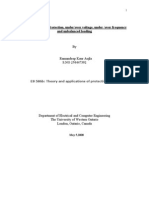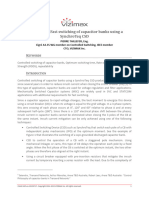Professional Documents
Culture Documents
Controlled Switching Device For Switching of Capacitor Bank
Original Title
Copyright
Available Formats
Share this document
Did you find this document useful?
Is this content inappropriate?
Report this DocumentCopyright:
Available Formats
Controlled Switching Device For Switching of Capacitor Bank
Copyright:
Available Formats
Volume 8, Issue 2, February – 2023 International Journal of Innovative Science and Research Technology
ISSN No:-2456-2165
Controlled Switching Device for Switching of
Capacitor Bank
Nihal Patil
Reactive Power Management & Power Quality Improvement Systems
Clariant Power System Ltd.,
Pune, India.
Abstract:- Controlled switching is used for elimination of the capacitor bank and circuit breaker. Controlling the circuit
harmful electrical transients upon planned switching of breaker to energize a capacitive load at zero voltage across the
mainly Capacitor Banks, Shunt reactors and Power contacts will eliminate harmful transients.
Transformers. The control switching of Capacitor Bank
using Controlled Switching Device (CSD) product has The Shunt Capacitor banks (or filter banks) may be
been used in order to reduce the inrush current when grounded or ungrounded. Directly after de-enrgizing, the bank
closing the circuit breaker. With the approach presented will be fully charged. Time relays normally block energizing
in this paper, power systems are capable of Switching on of the capacitor banks until they are discharged. The shunt
and off Capacitor Banks as needed. The basic aim is to capacitor banks may be arranged either as a single bank or in a
control closing to minimize the energizing transients back-to-back configuration. The strategies are worked out for
(voltage transients as well as inrush currents), to improve energizing all types of shunt capacitor banks and harmonic
interrupting performance and controlled opening can also filter banks (grounded as well as ungrounded). The strategies
be utilized. involve energizing the load close to voltage zero across the
circuit breaker contacts thereby avoiding energizing transients.
Keywords:- CSD, Optimum switching time, Controlled The strategy assumes that the banks are discharged prior to
switching of Capacitor Banks, Rate of decrease of Dielectric energizing. For controlled opening, the strategy is to avoid
Strength (RDDS), Switching Transients, Power quality, short arcing times resulting in the highest risk for reignitions or
Closing operation, Opening Operation. restrikes. The need for controlled opening will depend on
circuit breaker performance, load conditions and system
I. INTRODUCTION frequency.
Controlled switching device (CSD) has been used in the For some applications it may be useful to de-energize a
event of switching of Capacitor bank in order to reduce inrush capacitor bank or filter bank such that it will be left at a certain
current when closing the circuit breaker (CB) [1]. In this type voltage polarity. This is possible since the controller reference
of application, capacitor banks are used for voltage regulation is a rectified signal making it possible to set the target with
and filter applications. Mechanically Switched Capacitor respect to the voltage polarity.
systems (MSC) are widely used in SVC and STATCOM
applications with additional requirements for fast switching. II. WORKING PHILOSOPHY
When a Capacitor Bank is deenergized, it takes a certain In wye-grounded capacitor bank applications (see Figure
time for residual charge to disappear. In order to avoid 1), Independent Poles Operated (IPO) CBs are typically closed
energizing a capacitor bank while still charged, a time relay is when the source voltage is nearly equal to 0V. This zero
normally applied for blocking of the circuit breaker crossing of each phase occurs at 0°, 120° and 60° relative to
mechanism. Build-in discharge resistors will make sure that the phase A and at every subsequent half-cycle (180°). Since there
bank is discharged when the interlocking has expired. A typical is a 120° electrical phase shift between the phases, optimum
relay setting is 10 minutes from opening of the circuit breaker switching of capacitor banks cannot be optimized using a gang
to the earliest possible subsequent closing operation. operated CB unless it is equipped with pre-insertion resistors
or unless it has a staggered mechanism (one coil command but
A discharged capacitor is similar to a momentary short- delayed operation for each phase).
circuit when connected to a power source. If energized when
the source voltage is high, the connection results in voltage and
current transients that may cause serious problems. Depending
on the network configuration, the voltage surge may cause
dielectric breakdown somewhere in the high voltage network,
and low voltage equipment may suffer insulation damage or
malfunction. With back-to-back capacitor banks, the inrush
current may have high frequency and high amplitude. In
extreme cases, it may threaten the mechanical integrity of both
IJISRT23FEB457 www.ijisrt.com 631
Volume 8, Issue 2, February – 2023 International Journal of Innovative Science and Research Technology
ISSN No:-2456-2165
IV. OPTIMUM CLOSING TIME FOR DELTA
CONNECTED CAPACITOR BANK
When switching a wye-floating or delta connected
capacitor bank (Figure 3), the same principle of minimizing
sudden voltage changes across capacitors is applicable. In the
following example, phase A and C of a delta connected bank
are closed simultaneously at 30° because they have equal
amplitude. Since the same voltage is applied at points a and c
simultaneously, there is no current flowing into Cca or into the
parallel branch made of Cab and Cbc. At 120° relative to zero
crossing of phase A, phase B is then closed. At that moment,
the voltage at the b point is equal to 0 since phases A and C are
opposite polarities at ±V and therefore, inrush current is
avoided. This switching strategy repeats at every subsequent
When switching the CB at zero voltage, the current in the 60° phase shift.
capacitor is established gradually to its nominal value within
half a cycle: this switching strategy avoids high inrush current.
Switching the CB at any other point would cause inrush current
since capacitors oppose to sudden voltage changes.
III. EFFECTS OF SWITCHING CB AT WRONG
MOMENT
Figure 2 illustrates the switching of a wye-grounded
capacitor bank at random moment (left) compared to closing at
zero crossing of the source voltage (right). It can be seen on the
left that the peak inrush current is almost 4 times the nominal
current value. There is also switching transients on the voltage
waveform during the first cycle that are propagated everywhere
on the network. This could have been worst by switching the
Fig 3: Effects of CB repeatability on the Inrush current
capacitor bank at maximum voltage. However, by switching
the CB close to voltage zero crossing (right figure), the inrush
current is eliminated and the switching transients on the voltage
are minimized. Unfortunately, CBs are not perfect mechanical devices
and their operating time has some scattering due to coupling of
linkages, movement translators, cams, etc. In other words, for
the same operating conditions, the CB operating time slightly
varies, typically between ±0.5ms up to several milliseconds.
Figure 4 illustrates the measurement of the closing time of a
CB (horizontal axis) versus the number of occurrence (vertical
axis). A total of 21 operations were made on the CB in the same
operating conditions. It can be seen that most of the time, the
CB closing time is around 93.13ms (statistical average closing
time), but it can vary between 92.25ms up to 94.10ms. The
standard deviation of the operating time has been calculated to
0.51ms, meaning that 68% of the time, closing will occur
within 93.13 ±0.51 milliseconds and 95% of the time, closing
will occur within 93.13 ±1.02 milliseconds.
Random Energization Controlled Energization
Fig 2: Capacitor Bank Energization
IJISRT23FEB457 www.ijisrt.com 632
Volume 8, Issue 2, February – 2023 International Journal of Innovative Science and Research Technology
ISSN No:-2456-2165
As the contacts are moving toward each other, the voltage
across them may exceed the dielectric strength determined
by the contact separation distance. In this case, an arc will
be produced and electrical conduction will start in the CB.
When the contacts are touching each other, the arc
extinguishes and metallic conduction starts. The mobile
contact will continue its motion until fully engaged in the
stationary part.
Fig 4: Variation of CB timing
According to Figure 5, using a capacitor bank operated in
a 60Hz system, a ±1 ms scattering time indicates that the CB
may close while there is up to 37% of the nominal voltage
present at the source (19% with a ±0.5 ms scattering time). 1) CB Fully Opened Max. Dielectric Strength
Therefore, most of the time, there will be no inrush current. The
maximum inrush current expected from controlled switching
will be 2.7 times lower than the one resulting from random
switching. As a conclusion, the better the repeatability of the
CB, the lower the inrush current since the closing will occur
closer to the optimum point. Ideally, CBs used for controlled
switching of capacitor banks should have a repeatability
varying from ±0.5ms up to ±1ms.
2) CB in motion, closing Reduced Dielectric Strength
Fig 5: Effects of the CB repeatability at 60Hz
V. CIRCUIT BREAKER RATE OF DECREASE OF
DIELECTRIC STRENGTH
As illustrated in the Figure 6, a single chamber CB has 3) Arc between Contacts Voltage higher than dielectric
one mobile (left) and one stationary contact (right). It should is produced: Conduction strength
be noted that multiple chambers CBs are used at higher voltage,
but their operating principle remains the same.
In the opened position, the contacts are fully separated
and the dielectric strength of the CB is determined by the
distance between the contacts and the isolation media
properties (SF6, air, vacuum, etc.). When closing the CB, the
following sequence occurs:
The mobile contact is moved toward the fixed contact,
reducing both the distance and the dielectric strength of the
CB.
4) Contacts are touching: Full metallic conduction is
The contacts approach velocity determines the slope of the
Arc Extinction achieved
dielectric strength. This is called the Rate of Decrease of
Dielectric Strength (RDDS), which is normally expressed
Fig 6: CB closing
in kV/ms. This value is determined by the design of the CB.
IJISRT23FEB457 www.ijisrt.com 633
Volume 8, Issue 2, February – 2023 International Journal of Innovative Science and Research Technology
ISSN No:-2456-2165
VI. THE PRE-ARC TIME For example, the maximum voltage slope of a 230kV line
at 60Hz is 70.79kV/ms. When the CB has the same RDDS
The review of the closing sequence reveals that the value as the maximum voltage slope of the system, the RDDS
electrical conduction does not necessarily starts when the is said to be equal to 1 PU. For example, if a CB has an RDDS
contacts are touching each other (mechanical closure), but value of 50kV/ms, the RDDS value in PU is equal to:
rather when the arc is established between both contacts. As
illustrated in Figure 7, the pre-arc time varies according to the RDDS (PU) = RDDS (kV/ms) = 50kV/ms = 0.7 PU
voltage across the contacts and the RDDS slope. In this Slope (kV/ms) 70.79kV/ms
example, the mechanical closing moment is selected to be 120°
but the CB will start conducting around 33° sooner at 87° (left VIII. IMPORTANCE OF THE CB RDDS VALUE
most). However, when the mechanical closing moment is
selected to be 165° (center), the pre-arc time is reduced to 12° As illustrated in Figure 9, when the RDDS of the CB is
since the voltage is much lower. greater than the maximum system voltage slope (RDDS ≥ 1
PU), it is possible to close the CB at any point on the wave. It
The same pre-arc time variation occurs when the RDDS should be noted that the zero crossing point is the hardest target
slope varies. For example, if the mechanical closure occurs at to reach since the voltage slope is the highest at that time.
225° (rightmost), the same RDDS will produce a 15° pre-arc
time. As the RDDS slope is lowered, the pre-arc is increased to
23°.
Fig 9: Importance of RDDS for Capacitor Bank
In Figure 10 example, the CB RDDS is lower than 1 PU.
Fig 7: Effects of the CB RDDS at 60Hz
If the CB was controlled to do a mechanical closure at the zero
crossing, an important pre-arc time would occur since the
dielectric strength of the CB would be lower than the system
VII. RELATION BETWEEN CB RDDS & SYSTEM voltage. Therefore, the target point must be moved later (by
VOLTAGE around 45°) until the dielectric slope clears the system voltage.
The pre-arc will cause the CB to start conducting earlier at
In order to determine the pre-arc time, the RDDS of the around 15° and therefore, it will not be possible to avoid inrush
CB must be known. It is usually published as a kV/ms rating. current.
As illustrated in Figure 8, the maximum voltage slope of a
sinusoidal system occurs at zero crossing.
Fig 8: Voltage Slope Fig 10: Effects of RDDS on the Switching Point
This voltage slope is computed as follows: When the RDDS of the CB is lower than 1 PU, it is
therefore not possible to reach target points around the zero
Slope (KV/ms) = VL-L * √2 * 2* *f crossing, which is the optimum switching point for a wye-
√3 1000 grounded capacitor bank. In this type of application, a fast CB
Where, with an RDDS higher than 1 PU should be selected.
VL-L is the line to line voltage (kV)
f is the network frequency (Hz)
IJISRT23FEB457 www.ijisrt.com 634
Volume 8, Issue 2, February – 2023 International Journal of Innovative Science and Research Technology
ISSN No:-2456-2165
IX. CALCULATING OPTIMUM TARGET POINT &
ARC TIME
The optimum closing time for a wye-grounded
discharged capacitor bank is 0° since at this moment, there
won’t be sudden voltage change across the capacitor. However,
this target is only reachable when the RDDS of the CB is
greater than 1 PU. When lower than 1 PU, trigonometric
calculations must be done to determine the minimum reachable
closing time. Furthermore, the repeatability of the CB should
also be taken in account in this calculation. 1) CB is closed Min. Dielectric Strength
In Figure 11 example, if the minimum closing angle is
selected to be the target point, the CB mechanical scattering
may ignite an electrical arc almost ½ cycle sooner than the
objective: rather than closing the CB at an angle close to 0°, the
arc cause the CB to close near the peak of the voltage, causing
a very high inrush current in the capacitor bank.
2) Contact Separation: Voltage higher than
Arc is produced Dielectric strength
Fig 11: Choosing the Closing moment
X. OPENING THE CB ON A CAPACITOR BANK
When opening the CB on a capacitor bank, the following 3) Current flowing by Arc Current has to pass by zero
sequence occurs (see Figure 12): to stop flowing
The mobile contact is pulled away from the fixed contact,
but still maintaining the metallic conduction.
When the contacts are separated, an arc is produced
because the voltage is higher than the dielectric strength of
the CB. In the capacitor bank, the current is leading the
voltage by 90°.
As the contacts are moving away, the current continues
flowing by arc as the contacts are separated, even if the
voltage becomes lower than the dielectric strength of the
CB due to ionization.
The current is interrupted (CB opened) when: 4) Current zero crossing: Voltage lower than dielectric
the current becomes equal to 0 (the arc extinguish) Arc Extinction strength
the voltage at that moment is lower than the dielectric
strength of the CB Fig 12: CB opening
In Figure 12 opening example, the CB electrical opening
(interruption of current) will occur when the voltage is at peak
because the voltage is lagging the current by 90°. This means
that the load capacitor will stay charged at peak maximum
voltage, leaving a maximum difference voltage of 2 PU across
the CB after opening. This is illustrated in the Figure 13 where
an opening of the CB occurs at +90°.
IJISRT23FEB457 www.ijisrt.com 635
Volume 8, Issue 2, February – 2023 International Journal of Innovative Science and Research Technology
ISSN No:-2456-2165
thus determining the residual voltage trapped in each phase of
the capacitor bank. The capacitor bank residual voltage is
constantly evaluated by the CSD in order to dynamically
compute the optimum closing angle according to the source
voltage and the network frequency.
Figure 15 illustrates a rapid C-O-C sequence on a
capacitor bank with residual charges. When the CB is first
Fig 13: Voltage across the CB closed, the residual charge is around -0.7 PU and the CB is
closed when the line voltage is equal to the residual charge. The
CB is opened 3 cycles later. At the moment of current
interruption, the instantaneous voltage is measured by CSD and
However, since capacitors are not perfect devices, they calculations are done to evaluate the capacitor residual voltage
will gradually self-discharge to 0V after usually a period of 15 during its self-discharge. When the second closing command is
minutes (see Figure 14 with exaggerated discharge). Typically, received by CSD, the closing angle is dynamically adjusted so
the discharge time constant “τ” is in the minute range, meaning that the source voltage matches the residual charge at around
that it would take 1 minute for the capacitors to discharge to 0.8 PU. It can be noted that there is no inrush current resulting
36.8% of their initial voltage. After 5 time constants, the from the two close operations.
capacitor bank is considered to be fully discharged.
Fig 14: Capacitor Discharge
When controlling a capacitor bank switching using a Fig 15: Rapid C-O-C Sequence
CSD, it is important to account for the residual voltage that
exists on the capacitor bank. In many cases, a blocking timer is
used to control the CB closing. The timer is armed each time When receiving a close command, CSD is ready to close
the CB is opened and it blocks the closing of the CB. the C/B at the optimum angle, minimizing the latency between
the reception and the completion of the command. Using a
XI. FAST SWITCHING OF CAPACITOR BANK 60mS closing time circuit breaker, the 100ms response time to
command completion is guaranteed at 50Hz.
CSD product is perfectly adapted for fast switching of
capacitor banks and filters. In many applications such as static XII. CONCLUSION
VAR compensation (SVC) and STATCOM (static
compensators), very rapid switching sequences are required This document has presented the controlled switching of
where the operation of the CB cannot be blocked due to the capacitor banks. It has been seen that the best moment to close
presence of residual charges. In these applications, the CSD the CB depends on the configuration of the capacitor bank
must account for the capacitor/filter residual charge and the (wye-grounded, delta). When switching the CB at the optimum
self-discharge characteristics of the capacitor bank to time, inrush current is eliminated and voltage switching
determine the optimum switching point. For example, transients are minimized, improving the quality of the
immediately after opening the CB, the optimum closing time is waveform and reducing the stress on the electrical apparatus.
at peak voltage. However, 15 minutes after opening, the In order to provide a good control on the target angle, the CB
optimum closing moment is at zero crossing of the voltage. The must have a good repeatability (± 0.5 to ± 1.0 ms) and must
optimum closing moment becomes dynamic and varies also have a high Rate of Decrease of Dielectric Strength
according to the residual charge from 90° gradually to 0°. (RDDS ≥ 1 PU).
Using patented algorithms, the latest CSD products have When opening the CB, the arc is interrupted at zero
the capability of switching the capacitor banks according to the crossing of the current, and therefore the capacitors remain
residual voltage and self-discharge characteristics. Each time charged at full voltage. For rapid switching of capacitor banks,
the CB is switched, (by a protection trip or a voluntary the residual voltage on the capacitor bank must be taken in
command), the current and voltage waveforms are captured account before closing the CB, which is the case for the CSD
IJISRT23FEB457 www.ijisrt.com 636
Volume 8, Issue 2, February – 2023 International Journal of Innovative Science and Research Technology
ISSN No:-2456-2165
which provides advanced controlled switching functions for
almost every type of load and extensive CB monitoring
functions.
With the approach presented in this paper, power system
operators are capable of switching on and off capacitor banks
as needed. No longer is it required to wait for capacitor
discharge since CSD accounts for the residual voltage.
REFERENCES
[1]. "Guide for Application Lines Reactors Capacitors
Transformers (2nd Part)", ELECTRA, no. 185, pp. 37-57,
August 1999.
[2]. "Capacitive Current Switching – State of the Art",
ELECTRA, no. 155, pp. 33-63, August 1994.
[3]. G. Moraw et al., "Point-On-Wave Controlled Switching
of High Voltage Circuit-Breakers", Paper No. 13-02
Cigre 1988 Session.
[4]. J. A. Jardini, R. P. Casolari, G. Y. Saiki, M. Masuda, , L.
C.
Magrini, R. M. Jacobsen “Point-on-Wave Controller
Developed for Circuit Breaker Switching” ©2008 IEEE.
[5]. UrsKriisi, Student Member IEEE, and Klaus J. Frohlich,
Fellow IEEE “Controlled switching-suitability check for
already installed HVAC circuit breakers” IEEE
[6]. Controlled switching technologies, state-of-the-art,
Ito, H.; Transmission and Distribution Conference and
Exhibition 2002: Asia Pacific. IEEE/PES, Volume: 2,
Publication Year: 2002 , Page(s): 1455 - 1460 vol.2
[7]. Dan Goldsworthy and Tom Roseburg, Bonneville
Power Administration DemetriosTziouvaras and Jeff
Pope “Controlled Switching of HVAC Circuit Breakers:
Application Examples and Benefits ©2008 IEEE.
IJISRT23FEB457 www.ijisrt.com 637
You might also like
- 65A7355H01 - W-VACi User Manual Rev08 (UMA Mechanism)Document80 pages65A7355H01 - W-VACi User Manual Rev08 (UMA Mechanism)Mujahid Ahmed FadelNo ratings yet
- SANA Electrical & Telephone Cable GlandsDocument12 pagesSANA Electrical & Telephone Cable Glandsjehad azoozNo ratings yet
- Failure modes and testing of outdoor polymeric insulatorsDocument4 pagesFailure modes and testing of outdoor polymeric insulatorszerferuzNo ratings yet
- Site Acceptance Test ReportDocument3 pagesSite Acceptance Test ReportsamlashNo ratings yet
- Type KAVS: Check Synchronizing RelayDocument8 pagesType KAVS: Check Synchronizing RelayPanu Mark IINo ratings yet
- 2m HveDocument94 pages2m HveMani GaneshNo ratings yet
- Battery charging reportDocument10 pagesBattery charging reportNaveedNo ratings yet
- NavicDocument4 pagesNavicSarthak SamantaNo ratings yet
- Req 650Document96 pagesReq 650firoj malikNo ratings yet
- HybridDocument187 pagesHybridKamila WehbeNo ratings yet
- Nuisance TrippingDocument6 pagesNuisance TrippingSeindahNyaNo ratings yet
- Rdso-Spn 165-2012Document2 pagesRdso-Spn 165-2012sandeepNo ratings yet
- NR ScadaDocument1 pageNR Scadavishuraj2007No ratings yet
- Power Xpert UX - Presentation PDFDocument47 pagesPower Xpert UX - Presentation PDFpayolin77No ratings yet
- DOL Vs Soft StarterDocument12 pagesDOL Vs Soft Startersathishnallathambi100% (1)
- High-capacity bistable relays for lockout and control applicationsDocument4 pagesHigh-capacity bistable relays for lockout and control applicationsGabriel Maxo PapagalloNo ratings yet
- Questions From Relay and Protection SchemeDocument2 pagesQuestions From Relay and Protection SchemeChandan ChetriNo ratings yet
- Substation Maintenance Inspection ListDocument327 pagesSubstation Maintenance Inspection Listjohndavsg8022No ratings yet
- LM550A Instruction ManualDocument74 pagesLM550A Instruction ManualsunhuynhNo ratings yet
- Circuit Breaker 1Document94 pagesCircuit Breaker 1Mahesh Pushpakumara100% (1)
- FACTS devices control power flowsDocument1 pageFACTS devices control power flowsRojaNo ratings yet
- Practical Considerations in Surge Protection ArrestersDocument15 pagesPractical Considerations in Surge Protection ArrestersEl Comedor BenedictNo ratings yet
- I-Line II: Schneider BuswayDocument23 pagesI-Line II: Schneider BuswaymahmoudNo ratings yet
- 3 - Circuit Breaker Operation PrincipleDocument29 pages3 - Circuit Breaker Operation PrincipleCô Nàng Song TửNo ratings yet
- Capacitor Voltage TransformerDocument1 pageCapacitor Voltage Transformerdeep_sparklingNo ratings yet
- DCB Disconnecting Circuit Breakers ABB Buyers and Application GuideDocument48 pagesDCB Disconnecting Circuit Breakers ABB Buyers and Application GuideAnu Sun100% (1)
- CRS Condonation VPL - JustificationDocument7 pagesCRS Condonation VPL - JustificationRamojiNaikNo ratings yet
- Client Manipur State Guest Housing Corporation Ltd. electrification works tenderDocument26 pagesClient Manipur State Guest Housing Corporation Ltd. electrification works tenderKEYSTONE INFRA PVT LTDNo ratings yet
- Microsoft Word - STATOR PROTECTION. Final ReportDocument11 pagesMicrosoft Word - STATOR PROTECTION. Final ReportHari Krishna.MNo ratings yet
- Turret CT &tan Delta ReportDocument4 pagesTurret CT &tan Delta ReportSantosh BagadeNo ratings yet
- Rules for Ships / High Speed, Light Craft and Naval Surface Craft, January 2005 Pt.4 Ch.8 Sec.4 – Page 43Document2 pagesRules for Ships / High Speed, Light Craft and Naval Surface Craft, January 2005 Pt.4 Ch.8 Sec.4 – Page 43Stefanita0% (1)
- Megger Limited Mit1025 Megohmmeter DatasheetDocument6 pagesMegger Limited Mit1025 Megohmmeter DatasheetLukita Wahyu PermadiNo ratings yet
- Exertherm FAQ-US0711Document2 pagesExertherm FAQ-US0711bradNo ratings yet
- Ringmaster: Catalogue 2021Document184 pagesRingmaster: Catalogue 2021Daniel AgurtoNo ratings yet
- A Novel AC To AC Wireless Power Transfer SystemDocument6 pagesA Novel AC To AC Wireless Power Transfer Systemarunkumarmurugesan88No ratings yet
- Support Structures: Substation Design InstructionDocument9 pagesSupport Structures: Substation Design InstructionTony PedaNo ratings yet
- Two Stage OTA DesignDocument9 pagesTwo Stage OTA DesignakshayNo ratings yet
- 03 CB - Routine Tests-NewDocument15 pages03 CB - Routine Tests-NewaaaygugNo ratings yet
- Milli Volt DropDocument2 pagesMilli Volt Dropkazishah100% (1)
- Ar101 1N 8112W00002Document1 pageAr101 1N 8112W00002Dave Chaudhury100% (2)
- Scope: Surge Arrester Leakage Current AnalyserDocument6 pagesScope: Surge Arrester Leakage Current AnalyserEMD NSPCLNo ratings yet
- Easypact Cvs 2011engDocument84 pagesEasypact Cvs 2011engthiago_gomes7953No ratings yet
- Sec 03 PDFDocument29 pagesSec 03 PDFTalha AltafNo ratings yet
- ABB System Pro. M Compact, Miniature Circuit BreakersDocument75 pagesABB System Pro. M Compact, Miniature Circuit BreakersEliasNo ratings yet
- DWGS& DOC - FOR 24V-350A - 05.04.10Document14 pagesDWGS& DOC - FOR 24V-350A - 05.04.10Manik Singh100% (1)
- A Micro-Project Report On: Prepare A Chart On Thyristor Family Devices With Its SymbolDocument17 pagesA Micro-Project Report On: Prepare A Chart On Thyristor Family Devices With Its Symbolhrishikesh barveNo ratings yet
- CABLE Sheath Test - 3 15.10.17Document1 pageCABLE Sheath Test - 3 15.10.17Khalid AwanNo ratings yet
- CMGPS 588Document37 pagesCMGPS 588AleksandarNo ratings yet
- Designing An Astable MultivibratorDocument7 pagesDesigning An Astable Multivibratorjeyaganesh100% (3)
- Function TCS7 PA30Document7 pagesFunction TCS7 PA30Nasser Abdel RaoufNo ratings yet
- L-Tri 5 ArevaDocument48 pagesL-Tri 5 ArevaFernando Tamayo100% (2)
- Code of Practice For Design, Installation and Maintenancefor Overhead Power LinesDocument22 pagesCode of Practice For Design, Installation and Maintenancefor Overhead Power LinesStarla HillNo ratings yet
- Introduction To Live Line WorksDocument23 pagesIntroduction To Live Line WorksTEMIDAYONo ratings yet
- 33kV - Cap - Bank-SIKAP - Spec - FY 12-13 - 30.11.11-Cesc - 20 MVARDocument9 pages33kV - Cap - Bank-SIKAP - Spec - FY 12-13 - 30.11.11-Cesc - 20 MVARSatyajit RaiNo ratings yet
- RDSO STR for Electronic Signalling EquipmentsDocument5 pagesRDSO STR for Electronic Signalling EquipmentsVKG100% (1)
- Study of 220kV/132kV SubstationsDocument30 pagesStudy of 220kV/132kV SubstationsJITENDRA SAHUNo ratings yet
- CapacitoresDocument14 pagesCapacitoresLUIS EMILIO ESPINOZA HILARIONo ratings yet
- Investigation On Capacitor Switching Transient Limiter With A Three Phase Variable ResistanceDocument6 pagesInvestigation On Capacitor Switching Transient Limiter With A Three Phase Variable ResistanceArohi RoyNo ratings yet
- The Impact of Switching Capacitor Banks With Very High Inrush Current On SwitchgearDocument12 pagesThe Impact of Switching Capacitor Banks With Very High Inrush Current On SwitchgearRuben Eduardo ApazaNo ratings yet
- A Novel Method To Mitigate Commutation Failures in HVDC SystemsDocument6 pagesA Novel Method To Mitigate Commutation Failures in HVDC SystemsArturo Isidro Conde PérezNo ratings yet
- Formulation and Evaluation of Poly Herbal Body ScrubDocument6 pagesFormulation and Evaluation of Poly Herbal Body ScrubInternational Journal of Innovative Science and Research TechnologyNo ratings yet
- Comparatively Design and Analyze Elevated Rectangular Water Reservoir with and without Bracing for Different Stagging HeightDocument4 pagesComparatively Design and Analyze Elevated Rectangular Water Reservoir with and without Bracing for Different Stagging HeightInternational Journal of Innovative Science and Research TechnologyNo ratings yet
- Explorning the Role of Machine Learning in Enhancing Cloud SecurityDocument5 pagesExplorning the Role of Machine Learning in Enhancing Cloud SecurityInternational Journal of Innovative Science and Research TechnologyNo ratings yet
- A Review: Pink Eye Outbreak in IndiaDocument3 pagesA Review: Pink Eye Outbreak in IndiaInternational Journal of Innovative Science and Research TechnologyNo ratings yet
- Design, Development and Evaluation of Methi-Shikakai Herbal ShampooDocument8 pagesDesign, Development and Evaluation of Methi-Shikakai Herbal ShampooInternational Journal of Innovative Science and Research Technology100% (3)
- Studying the Situation and Proposing Some Basic Solutions to Improve Psychological Harmony Between Managerial Staff and Students of Medical Universities in Hanoi AreaDocument5 pagesStudying the Situation and Proposing Some Basic Solutions to Improve Psychological Harmony Between Managerial Staff and Students of Medical Universities in Hanoi AreaInternational Journal of Innovative Science and Research TechnologyNo ratings yet
- A Survey of the Plastic Waste used in Paving BlocksDocument4 pagesA Survey of the Plastic Waste used in Paving BlocksInternational Journal of Innovative Science and Research TechnologyNo ratings yet
- Electro-Optics Properties of Intact Cocoa Beans based on Near Infrared TechnologyDocument7 pagesElectro-Optics Properties of Intact Cocoa Beans based on Near Infrared TechnologyInternational Journal of Innovative Science and Research TechnologyNo ratings yet
- Auto Encoder Driven Hybrid Pipelines for Image Deblurring using NAFNETDocument6 pagesAuto Encoder Driven Hybrid Pipelines for Image Deblurring using NAFNETInternational Journal of Innovative Science and Research TechnologyNo ratings yet
- Cyberbullying: Legal and Ethical Implications, Challenges and Opportunities for Policy DevelopmentDocument7 pagesCyberbullying: Legal and Ethical Implications, Challenges and Opportunities for Policy DevelopmentInternational Journal of Innovative Science and Research TechnologyNo ratings yet
- Navigating Digitalization: AHP Insights for SMEs' Strategic TransformationDocument11 pagesNavigating Digitalization: AHP Insights for SMEs' Strategic TransformationInternational Journal of Innovative Science and Research TechnologyNo ratings yet
- Hepatic Portovenous Gas in a Young MaleDocument2 pagesHepatic Portovenous Gas in a Young MaleInternational Journal of Innovative Science and Research TechnologyNo ratings yet
- Review of Biomechanics in Footwear Design and Development: An Exploration of Key Concepts and InnovationsDocument5 pagesReview of Biomechanics in Footwear Design and Development: An Exploration of Key Concepts and InnovationsInternational Journal of Innovative Science and Research TechnologyNo ratings yet
- Automatic Power Factor ControllerDocument4 pagesAutomatic Power Factor ControllerInternational Journal of Innovative Science and Research TechnologyNo ratings yet
- Formation of New Technology in Automated Highway System in Peripheral HighwayDocument6 pagesFormation of New Technology in Automated Highway System in Peripheral HighwayInternational Journal of Innovative Science and Research TechnologyNo ratings yet
- Drug Dosage Control System Using Reinforcement LearningDocument8 pagesDrug Dosage Control System Using Reinforcement LearningInternational Journal of Innovative Science and Research TechnologyNo ratings yet
- The Effect of Time Variables as Predictors of Senior Secondary School Students' Mathematical Performance Department of Mathematics Education Freetown PolytechnicDocument7 pagesThe Effect of Time Variables as Predictors of Senior Secondary School Students' Mathematical Performance Department of Mathematics Education Freetown PolytechnicInternational Journal of Innovative Science and Research TechnologyNo ratings yet
- Mobile Distractions among Adolescents: Impact on Learning in the Aftermath of COVID-19 in IndiaDocument2 pagesMobile Distractions among Adolescents: Impact on Learning in the Aftermath of COVID-19 in IndiaInternational Journal of Innovative Science and Research TechnologyNo ratings yet
- Securing Document Exchange with Blockchain Technology: A New Paradigm for Information SharingDocument4 pagesSecuring Document Exchange with Blockchain Technology: A New Paradigm for Information SharingInternational Journal of Innovative Science and Research TechnologyNo ratings yet
- Perceived Impact of Active Pedagogy in Medical Students' Learning at the Faculty of Medicine and Pharmacy of CasablancaDocument5 pagesPerceived Impact of Active Pedagogy in Medical Students' Learning at the Faculty of Medicine and Pharmacy of CasablancaInternational Journal of Innovative Science and Research TechnologyNo ratings yet
- Intelligent Engines: Revolutionizing Manufacturing and Supply Chains with AIDocument14 pagesIntelligent Engines: Revolutionizing Manufacturing and Supply Chains with AIInternational Journal of Innovative Science and Research TechnologyNo ratings yet
- Enhancing the Strength of Concrete by Using Human Hairs as a FiberDocument3 pagesEnhancing the Strength of Concrete by Using Human Hairs as a FiberInternational Journal of Innovative Science and Research TechnologyNo ratings yet
- Exploring the Clinical Characteristics, Chromosomal Analysis, and Emotional and Social Considerations in Parents of Children with Down SyndromeDocument8 pagesExploring the Clinical Characteristics, Chromosomal Analysis, and Emotional and Social Considerations in Parents of Children with Down SyndromeInternational Journal of Innovative Science and Research TechnologyNo ratings yet
- Supply Chain 5.0: A Comprehensive Literature Review on Implications, Applications and ChallengesDocument11 pagesSupply Chain 5.0: A Comprehensive Literature Review on Implications, Applications and ChallengesInternational Journal of Innovative Science and Research TechnologyNo ratings yet
- Teachers' Perceptions about Distributed Leadership Practices in South Asia: A Case Study on Academic Activities in Government Colleges of BangladeshDocument7 pagesTeachers' Perceptions about Distributed Leadership Practices in South Asia: A Case Study on Academic Activities in Government Colleges of BangladeshInternational Journal of Innovative Science and Research TechnologyNo ratings yet
- Advancing Opthalmic Diagnostics: U-Net for Retinal Blood Vessel SegmentationDocument8 pagesAdvancing Opthalmic Diagnostics: U-Net for Retinal Blood Vessel SegmentationInternational Journal of Innovative Science and Research TechnologyNo ratings yet
- The Making of Self-Disposing Contactless Motion-Activated Trash Bin Using Ultrasonic SensorsDocument7 pagesThe Making of Self-Disposing Contactless Motion-Activated Trash Bin Using Ultrasonic SensorsInternational Journal of Innovative Science and Research TechnologyNo ratings yet
- Natural Peel-Off Mask Formulation and EvaluationDocument6 pagesNatural Peel-Off Mask Formulation and EvaluationInternational Journal of Innovative Science and Research TechnologyNo ratings yet
- Beyond Shelters: A Gendered Approach to Disaster Preparedness and Resilience in Urban CentersDocument6 pagesBeyond Shelters: A Gendered Approach to Disaster Preparedness and Resilience in Urban CentersInternational Journal of Innovative Science and Research TechnologyNo ratings yet
- Handling Disruptive Behaviors of Students in San Jose National High SchoolDocument5 pagesHandling Disruptive Behaviors of Students in San Jose National High SchoolInternational Journal of Innovative Science and Research TechnologyNo ratings yet
- Multi-Band Booster With HRLB - In-Band Routed DCN Solution GuideDocument26 pagesMulti-Band Booster With HRLB - In-Band Routed DCN Solution GuideAchintha AluthmanageNo ratings yet
- Kidney AnatomyDocument55 pagesKidney AnatomyMohammad zreadNo ratings yet
- Differential Analysis of Fluid FlowDocument42 pagesDifferential Analysis of Fluid FlowAmr Faisal RaghebNo ratings yet
- Cics Class 05Document18 pagesCics Class 05HarithaNo ratings yet
- B 2Document12 pagesB 2Mohamed Sayed Abdel GaffarNo ratings yet
- List of Practical Cs With SolutionDocument57 pagesList of Practical Cs With SolutionArjun KalaNo ratings yet
- Failure Mode For Gas CHromatographDocument2 pagesFailure Mode For Gas CHromatographardi-No ratings yet
- Selection: Open-Type Reciprocating Compressors: Input ValuesDocument1 pageSelection: Open-Type Reciprocating Compressors: Input ValuesYuli RahmawatiNo ratings yet
- Jurnal IlmiahDocument12 pagesJurnal IlmiahROSSITANo ratings yet
- 250+ C Programs for Practice PDF Free DownloadDocument13 pages250+ C Programs for Practice PDF Free Downloadsubhanshu sahuNo ratings yet
- ASME - Performance Test CodesDocument1 pageASME - Performance Test CodesanoopkntpcNo ratings yet
- Applications and Interpretation Standard SpecimensDocument56 pagesApplications and Interpretation Standard SpecimensNahir ClaraNo ratings yet
- Calentador Catalitico de TuberíasDocument2 pagesCalentador Catalitico de TuberíasDavid RomeroNo ratings yet
- SQL SlidesDocument65 pagesSQL SlidescopsamostoNo ratings yet
- Mste 3.0 Plane Geometry Hand OutsDocument8 pagesMste 3.0 Plane Geometry Hand OutsJasmine MartinezNo ratings yet
- 34a65 PDFDocument33 pages34a65 PDFvinu100% (2)
- PermutationDocument3 pagesPermutationKhairuddin MuhamadNo ratings yet
- Treatment of Electroplating Wastewater Containing Cu2+, ZN 2+ and CR (VI) by ElectrocoagulationDocument8 pagesTreatment of Electroplating Wastewater Containing Cu2+, ZN 2+ and CR (VI) by ElectrocoagulationAnonymous ZAr1RKNo ratings yet
- Binder Modul WMS 10Document52 pagesBinder Modul WMS 10sandhiakhmadNo ratings yet
- AC axial compact fan technical specificationsDocument5 pagesAC axial compact fan technical specificationsdhanasekhar27No ratings yet
- A Framework For Transforming Artifacts From Data Flow Diagrams ToDocument7 pagesA Framework For Transforming Artifacts From Data Flow Diagrams Tow_mahmudNo ratings yet
- UMTS Chap6Document33 pagesUMTS Chap6NguyenDucTaiNo ratings yet
- 006 PVC & CPVC Schedule 80 Fittings, Unions Tank Adapters, Expansion Joints & Saddles PDFDocument92 pages006 PVC & CPVC Schedule 80 Fittings, Unions Tank Adapters, Expansion Joints & Saddles PDFnicacio_89507470No ratings yet
- NEO PGM 'AND'/'OR' FunctionalityDocument5 pagesNEO PGM 'AND'/'OR' FunctionalityAndre EinsteinNo ratings yet
- Topic 8-Mean Square Estimation-Wiener and Kalman FilteringDocument73 pagesTopic 8-Mean Square Estimation-Wiener and Kalman FilteringHamza MahmoodNo ratings yet
- Harduaganj Thermal Power Plant by Geetesh SharmaDocument66 pagesHarduaganj Thermal Power Plant by Geetesh Sharmageeteshaccurate100% (1)
- Antenna Specifications Electrical PropertiesDocument2 pagesAntenna Specifications Electrical PropertiesLuis Adolfo Mazini RodriguesNo ratings yet
- Complete trip-free loop, PFC and PSC testerDocument2 pagesComplete trip-free loop, PFC and PSC testerGermanilloZetaNo ratings yet
- EWDLEWML Servo Motor DriverDocument14 pagesEWDLEWML Servo Motor DriverWaleed LemsilkhiNo ratings yet
- Tutorial - Lecture 3 SolutionsDocument10 pagesTutorial - Lecture 3 SolutionsBastián Olfos MárquezNo ratings yet




